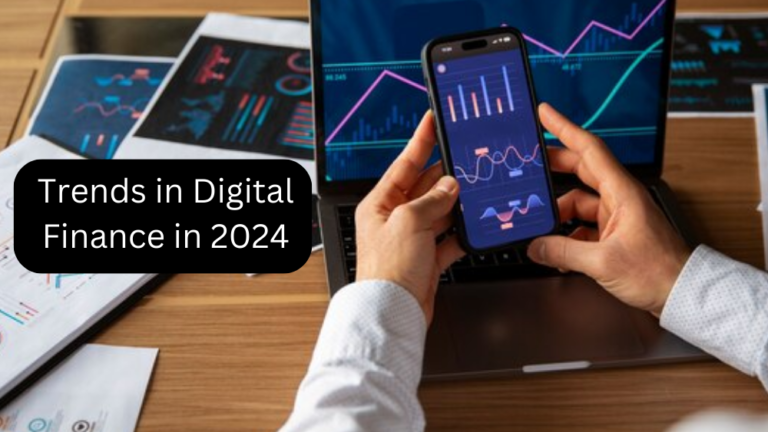Digital finance is buzzing around the world because many companies are heavily investing in digitalization to create a safe and secure payment system. By taking monetary transactions online and making them mainstream, more than $100 billion in funding is being provided to reshape the financial world.
It is sometimes hard to stay on top of new financial ways and trends, but keeping yourself aware of them is important. So, here are all the leading trends in digital finance for 2024 that will reshape the future of finance.
Digital Finance Trends in 2024
Digital trends are the new digital adaptations and techniques that are innovated or employed in finance to make it accessible, secure, and optimized for all types of users.
Blockchain integration
A secure and transparent system is required in the financial industry, and thus blockchain takes center stage here. The integration of blockchain into the financial system will almost eliminate data manipulation and hacking. Blockchain integration will help further in.
- Enables the tokenization of shares. This would help transform traditional assets and would help in transferring investments easily without any additional cost. Mainly, it would help in cost efficiency.
- The financial institution can streamline its process with blockchain, for it allows data and asset organization on the public ledger, which reduces the complexity of the traditional method. So, users can now have transparent and immutable data with blockchain.
- Blockchain technology is being redesigned to be more ecologically friendly, in line with sustainability objectives, and to represent a responsible approach to tech integration in finance. There are significant initiatives to make blockchain technology greener in 2024.
Mobile banking will reach the top
Finance will be primarily digital and mobile in the future. Artificial intelligence (AI) is at the center of financial institutions’ technological advancements, which are a result of growing consumer demand for digital banking services.
As more legacy banks make their application programming interfaces (APIs) available to fintech and third-party app developers, the rise of digital mobile banking services. The use of mobile banking for everything from budget inquiries to report generation will only increase.
Conventional spreadsheet data will eventually be replaced by easily accessible, visually stimulating information through data science. In 2024, digital finance offers a streamlined way of getting mortgages approved with faster processing and potentially more lenders to choose from. Even insurance claims, loan transactions, conversions, and more will be streamlined and simplified for each user with customization.
Artificial intelligence and machine learning
Implementation of AI in fintech businesses will become a core aspect in 2024. AI enables the financial industry to integrate automation, which eliminates the chances of repetitive tasks with minimal human supervision.
The financial industry can use AI and machine learning by integrating conversational AI to manage clients. The growth rate is expected to reach 3000% with a chatbot system, as it will help quickly and accurately resolve user queries. Driven by AI and automation, Digital Portfolio Management Services in 2024 offer personalized investment strategies with a focus on accessibility. Machine learning provides systems that will learn from themselves to offer smooth automation of repetitive tasks in the banking sector.
Also, the FinTech industries will shift their focus to the Metaverse concept since people are showing more interest in buying digital assets like cryptocurrencies, NFTs, digital tokens, lands, and properties, all of which are growing exponentially.
Enterprise Resource Planning (ERP)
Applications for finance and microservices will test ERP. Large suppliers such as SAP and Oracle must be agile to stay relevant on the changing road. ERP providers have already incorporated digital technologies like blockchain, automation, and cognitive tools into their products.
Expect a shift in the market as new companies enter the ERP space with specialized applications and microservices that will introduce multiple finance services with ease. Additionally, using cloud-based ERP will enable businesses to remain competitive with secured transactions and ease of access.
Read: Lowes Credit Card Login and the Advantages
Auto-fraud detection and cybersecurity
Another aspect of digital finance is heavy investment in auto-fraud detection and cybersecurity. 70% of the financial buyers are expressing their intention to expand their spending on software with a clear focus on cybersecurity and data protection. This surge is a reason for one of the most significant challenges: cyber security concerns. However, with AI, blockchain, and IoT, the fintech sector is innovating drastically for security and against unwanted threats.
Buy Now, Pay Later (BNPL)
2023 was the year that BNPL became a widely used payment method. It increases the purchasing power of consumers by allowing them to buy and own a product now and pay for it in parts at their convenience. BNPL payments are growing at an exponential rate, and by 2026, they are foreseen to make up almost 25% of all global e-commerce transactions, up from a mere 9% in 2021.
Business Intelligence (BI) and Services
Data on demand, a feature of business intelligence (BI) technology, enables organizations to track both financial and non-financial KPIs and identify value drivers and growth prospects. By 2024, real-time data handling will be quick and easy, thanks to BI solutions. The financial organization will optimize its growth in several areas with strong evidence in support of upcoming go-to-market plans and improved services in general.
New Fields Emergence
The need for future finance skills will continue to be emphasized in 2024, with a focus on technical skills and jobs like data scientists, business analysts, and storytellers. Beyond the technical skills required for particular jobs, important future-oriented qualities are a strong customer service orientation, flexibility, and good collaboration skills.
Ending Note
Digital finance trends are going to reshape the financial world. It will bring innovation and a shift in our thinking and transactional approach. Automation, data science, and data management are going to be the epicenters. With digital finance on the rise in 2024, Women’s Financial Power is gaining momentum as more women gain access to tools and resources for managing their finances. Blockchain and AI will be a major helping hand in resolving hacking, cyber threats, and manipulation issues, bringing transparency into data management.
Additionally, AI and machine learning will lend an additional layer of security and can work more effectively by integrating them with fraud detection technology.
However, financial service providers must think twice before investing in these technologies and check whether they are ready for the digital change. Thus, there is a need to develop a realistic and holistic strategy so that these technologies can be easily integrated and accelerate the financial landscape for a secure and improved tomorrow.
Author’s Bio:
Harikrishna Kundariya is the Co-founder, Director, & Marketer of eSparkBiz Technologies – an excellent Software Development Company. Also, a notable IoT, ChatBot & Blockchain-savvy Developer.




